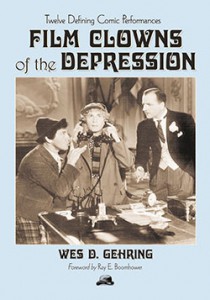Film Clowns of the Depression
Twelve Defining Comic Performances


Average rating: ![]()
| 0 | rating | |
| 0 | rating | |
| 0 | rating | |
| 0 | rating |
Your rating: -
Book Presentation:
The 1930s are routinely considered sound film’s greatest comedy era. Though this golden age encompassed various genres of laughter, clown comedy is the most basic type. This work examines the Depression decade’s most popular type of comedy—the clown, or personality comedian. Focusing upon the Depression era, the study filters its analysis through twelve memorable pictures. Each merits an individual chapter, in which it is critiqued. The films are deemed microcosmic representatives of the comic world and discussed in this context.
While some of the comedians in this text have generated a great deal of previous analysis, funnymen like Joe E. Brown and Eddie Cantor are all but forgotten. Nevertheless, they were comedy legends in their time, and their legacy, as showcased in these movies, merits rediscovery by today’s connoisseur of comedy. Even this book’s more familiar figures, such as Charlie Chaplin and the Marx Brothers, are often simply relegated to being recognizable pop culture icons whose work has been neglected in recent years. This book attempts to address these oversights and to re-expose the brilliance and ingenuity with which the screen clowns contributed a comic resiliency that was desperately needed during the Depression and can still be greatly appreciated today. The films discussed are City Lights (1931, Chaplin), The Kid From Spain (1932, Cantor), She Done Him Wrong (1933, Mae West), Duck Soup (1933, Marx Brothers), Sons of the Desert (1933, Laurel and Hardy), Judge Priest (1934, Will Rogers), It’s a Gift (1934, W.C. Fields), Alibi Ike (1935, Brown), A Night at the Opera (1935, Marx Brothers), Modern Times (1936, Chaplin), Way Out West (1937, Laurel and Hardy), and The Cat and the Canary (1939, Bob Hope).
About the Author:
Wes D. Gehring is a distinguished professor of film at Ball State University and associate media editor for USA Today magazine, for which he also writes the column “Reel World.” He is the author of 40 film books, including biographies of James Dean, Carole Lombard, Steve McQueen, Robert Wise, Red Skelton and Charlie Chaplin.
Press Reviews:
"Gehring remains supreme in film comedy scholarship"—Choice.
See the publisher website: McFarland & Co
> From the same author:
Kinds of American Film Comedy (2024)
Six Core Genres and Their Literary Roots
Subject: Genre > Comedy/Humor
Charlie Chaplin and A Woman of Paris (2021)
The Genesis of a Misunderstood Masterpiece
Subject: One Film > A Woman of Paris
Hitchcock and Humor (2019)
Modes of Comedy in Twelve Defining Films
Subject: Director > Alfred Hitchcock
Buster Keaton in His Own Time (2018)
What the Responses of 1920s Critics Reveal
Subject: Director > Buster Keaton
Movie Comedians of the 1950s (2016)
Defining a New Era of Big Screen Comedy
Subject: Genre > Comedy/Humor
Chaplin's War Trilogy (2014)
An Evolving Lens in Three Dark Comedies, 1918–1947
Subject: One Film > Shoulder Arms, The Great Dictator, Monsieur Verdoux
Forties Film Funnymen (2010)
The Decade's Great Comedians at Work in the Shadow of War
Subject: Genre > Comedy/Humor
Mr. Deeds Goes to Yankee Stadium (2004)
Baseball Films in the Capra Tradition
Subject: On Films > Film selections
> On a related topic:
Hollywood Screwball Comedy 1934-1945 (2023)
Sex, Love, and Democratic Ideals
Subject: Genre > Comedy/Humor
The Art of the Screwball Comedy (2013)
Madcap Entertainment from the 1930s to Today
Subject: Genre > Comedy/Humor
The Screwball Comedy Films (2001)
A History and Filmography, 1934-1942
by Duane Byrge and Robert Milton Miller
Subject: Genre > Comedy/Humor
Romantic Comedy in Hollywood (1998)
From Lubitsch to Sturges
by James Harvey
Subject: Genre > Comedy/Humor
Mock Classicism (2018)
Latin American Film Comedy, 1930–1960
by Nilo Couret
Subject: Countries > Latin America
A Chorus Of Raspberries (2000)
British Film Comedy 1929-1939
by David Sutton
Subject: Countries > Great Britain